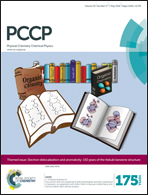Electron conjugation versus π–π repulsion in substituted benzenes: why the carbon–nitrogen bond in nitrobenzene is longer than in aniline
Abstract
Gas-phase electron diffraction experiments show that the C–N bond in aniline (1.407 Å) is significantly shorter than in nitrobenzene (1.486 Å). It is known that the amino group is electron-donating and the nitro group is electron-withdrawing, and both substitution groups can effectively conjugate with benzene. Thus, it is puzzling why the C–N bond in nitrobenzene is even longer than the single C–N bond in methylamine (1.472 Å). In this work, we performed computations by strictly localizing the π electrons with the block-localized wavefunction (BLW) method, which is a variant of ab initio valence bond theory. Geometry optimizations of electron-localized states, where the conjugation over the C–N bond is quenched, show that the conjugation in nitrobenzene is only half of the conjugation in aniline. But even in optimal electron-localized states, the C–N bond in nitrobenzene is still 0.074 Å longer than in aniline. As a consequence, it is indeed not the π conjugation which is responsible for the disparity of the C–N bond distances in these systems. Instead, we demonstrated that the π–π repulsion, which is contributed by both Pauli exchange and electrostatic interaction, plays the key role in this “abnormal” behavior. Notably, the π resonance within the nitro group generates a considerable dipole, which repels the π electrons in the benzene ring. The deactivation of the resonance within the nitro group significantly shortens the C–N bond by 0.06 Å. The unfavorable π–π electrostatic repulsion is further exemplified by N2O4. In fact, the destabilizing π–π repulsion is ubiquitous but largely neglected in conjugated systems where only the stabilizing conjugation is the focus. Experimental phenomena such as the C–N bond distances in aniline and nitrobenzene result from the balance of both stabilizing and destabilizing forces.

- This article is part of the themed collection: Electron delocalization and aromaticity: 150 years of the Kekulé benzene structure

 Please wait while we load your content...
Please wait while we load your content...